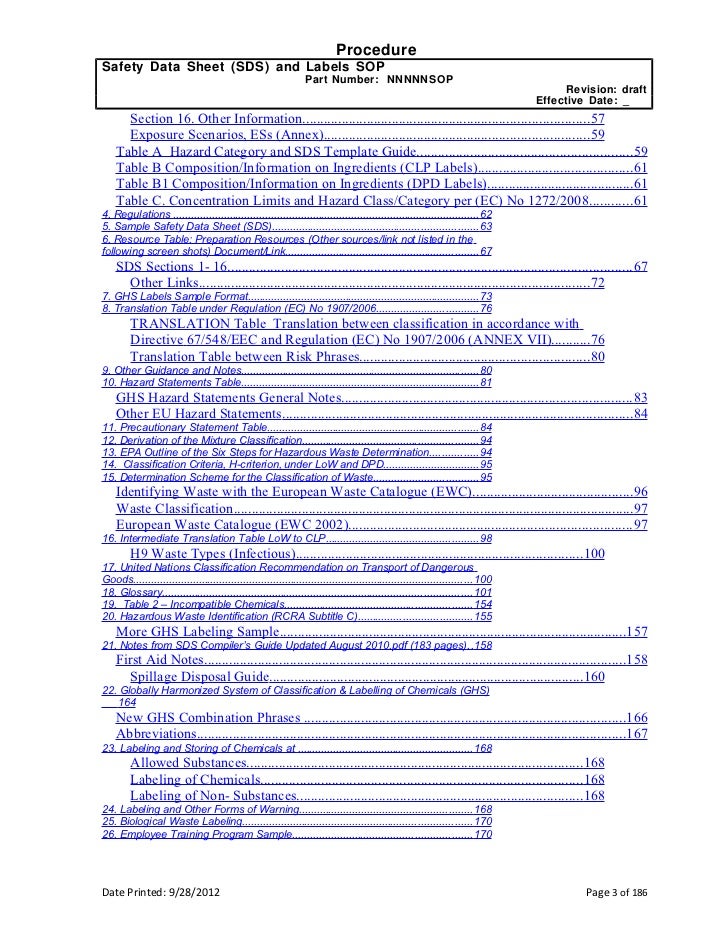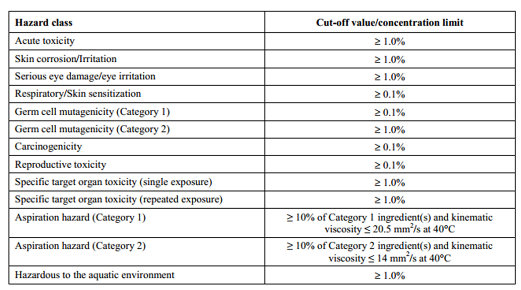Sds Section 7 Storage
The information in this section, combined with information from Section 7 (Handling and Storage) and Section 10 (Stability and Reactivity) can be used to determine where a certain material should be stored (for example, flammable liquids should be stored in specially designed facilities away from incompatible chemicals). For exposure controls and personal protection, refer to section 8 of the SDS. For waste disposal, refer to section 13 of the SDS. SECTION 7: Handling and storage Personal precautions, protective equipment, and emergency procedures Do not breathe mist or vapor. Do not get in eyes, on skin, or on clothing. Do not taste or swallow.
A —is a document prepared by chemical manufacturers for any chemical which presents a hazard to health and safety. A safety data sheet includes information about each chemical, covering the physical and environmental hazards, precautions for safe handling, storage, and transportation of the chemical, and more.There are 16 sections in a safety data sheet.
Let’s walk through each one:. Section 1 identifies the chemical on the SDS as well as its intended use.
BriefHazard Communication Standard: Safety Data SheetsThe Hazard Communication Standard (HCS)(29 CFR 1910.1200(g)), revised in 2012, requiresthat the chemical manufacturer, distributor,or importer provide Safety Data Sheets(SDSs) (formerly MSDSs or Material SafetyData Sheets) for each hazardous chemicalto downstream users to communicateinformation on these hazards. The informationcontained in the SDS is largely the same asthe MSDS, except now the SDSs are requiredto be presented in a consistent user-friendly,16-section format. This brief provides guidanceto help workers who handle hazardouschemicals to become familiar with the formatand understand the contents of the SDSs.The SDS includes information such as theproperties of each chemical; the physical,health, and environmental health hazards;protective measures; and safety precautionsfor handling, storing, and transporting thechemical.
The information contained in the SDSmust be in English (although it may be in otherlanguages as well). In addition, OSHA requiresthat SDS preparers provide specific minimuminformation as detailed in Appendix D of29 CFR 1910.1200. The SDS preparers mayalso include additional information in varioussection(s).Sections 1 through 8 contain generalinformation about the chemical, identification,hazards, composition, safe handling practices,and emergency control measures (e.g., firefighting).
This information should be helpful tothose that need to get the information quickly.Sections 9 through 11 and 16 contain othertechnical and scientific information, such asphysical and chemical properties, stabilityand reactivity information, toxicologicalinformation, exposure control information,and other information including the date ofpreparation or last revision. The SDS mustalso state that no applicable information wasfound when the preparer does not find relevantinformation for any required element.The SDS must also contain Sections 12through 15, to be consistent with the UNGlobally Harmonized System of Classificationand Labeling of Chemicals (GHS), but OSHAwill not enforce the content of these sectionsbecause they concern matters handled by otheragencies.A description of all 16 sections of the SDS,along with their contents, is presented below. Section 1: IdentificationThis section identifies the chemical on the SDS as well as the recommendeduses. It also providesthe essential contact information of the supplier. The required informationconsists of:. Product identifier used on the label and any other common names or synonyms by which the substance is known. Name, address, phone number of the manufacturer, importer, or other responsible party, and emergency phone number.
Section 4 Of An Sds
Recommended use of the chemical (e.g., a brief description of what it actually does, such as flame retardant) and any restrictions on use (including recommendations given by the supplier). Section 2: Hazard(s) IdentificationThis section identifies the hazards of the chemical presented on the SDS and the appropriate warning information associated with those hazards. Section 3: Composition/Information on IngredientsThis section identifies the ingredient(s) contained in the product indicated on the SDS, including impurities and stabilizing additives. This section includes information on substances, mixtures, and all chemicals where a trade secret is claimed. Section 4: First-Aid MeasuresThis section describes the initial care that should be given by untrained responders to an individual who has been exposed to the chemical. The required information consists of:.
Necessary first-aid instructions by relevant routes of exposure (inhalation, skin and eye contact, and ingestion). Description of the most important symptoms or effects, and any symptoms that are acute or delayed.
Recommendations for immediate medical care and special treatment needed, when necessary. Section 5: Fire-Fighting MeasuresThis section provides recommendations for fighting a fire caused by the chemical. The required information consists of:. Recommendations of suitable extinguishing equipment, and information about extinguishing equipment that is not appropriate for a particular situation.
Advice on specific hazards that develop from the chemical during the fire, such as any hazardous combustion products created when the chemical burns. Recommendations on special protective equipment or precautions for firefighters. Section 6: Accidental Release MeasuresThis section provides recommendations on the appropriate response to spills, leaks, or releases, including containment and cleanup practices to prevent or minimize exposure to people, properties, or the environment. It may also include recommendations distinguishing between responses for large and small spills where the spill volume has a significant impact on the hazard.
Section 7: Handling and StorageThis section provides guidance on the safe handling practices and conditions for safe storage of chemicals. The required information consists of:. Precautions for safe handling, including recommendations for handling incompatible chemicals, minimizing the release of the chemical into the environment, and providing advice on general hygiene practices (e.g., eating, drinking, and smoking in work areas is prohibited).
Recommendations on the conditions for safe storage, including any incompatibilities. Provide advice on specific storage requirements (e.g., ventilation requirements). Section 8: Exposure Controls/Personal ProtectionThis section indicates the exposure limits, engineering controls, and personal protective measures that can be used to minimize worker exposure. Section 9: Physical and Chemical PropertiesThis section identifies physical and chemical properties associated with the substance or mixture. The minimum required information consists of:. Appearance (physical state, color, etc.);. Upper/lower flammability or explosive limits;.
Sds Definition

Odor;. Vapor pressure;.
Odor threshold;. Vapor density;. pH;.
Relative density;. Melting point/freezing point;. Solubility(ies);. Initial boiling point and boiling range;.
Flash point;. Evaporation rate;. Flammability (solid, gas);. Partition coefficient: n-octanol/water;. Auto-ignition temperature;.
Decomposition temperature; and. Viscosity.The SDS may not contain every item on the above list because information may not be relevant or is not available. When this occurs, a notation to that effect must be made for that chemical property. Manufacturers may also add other relevant properties, such as the dust deflagration index (Kst) for combustible dust, used to evaluate a dust's explosive potential. Section 10: Stability and ReactivityThis section describes the reactivity hazards of the chemical and the chemical stability information. This section is broken into three parts: reactivity, chemical stability, and other.
The required information consists of:Reactivity. Description of the specific test data for the chemical(s). Section 11: Toxicological InformationThis section identifies toxicological and health effects information or indicates that such data are not available. The required information consists of:.
Information on the likely routes of exposure (inhalation, ingestion, skin and eye contact). The SDS should indicate if the information is unknown. Description of the delayed, immediate, or chronic effects from short- and long-term exposure. The numerical measures of toxicity (e.g., acute toxicity estimates such as the LD50 (median lethal dose)) - the estimated amount of a substance expected to kill 50% of test animals in a single dose. Description of the symptoms.

This description includes the symptoms associated with exposure to the chemical including symptoms from the lowest to the most severe exposure. Indication of whether the chemical is listed in the National Toxicology Program (NTP) Report on Carcinogens (latest edition) or has been found to be a potential carcinogen in the International Agency for Research on Cancer (IARC) Monographs (latest editions) or found to be a potential carcinogen by OSHA. Section 12: Ecological Information (non-mandatory)This section provides information to evaluate the environmental impact of the chemical(s) if it were released to the environment. Section 13: Disposal Considerations (non-mandatory)This section provides guidance on proper disposal practices, recycling or reclamation of the chemical(s) or its container, and safe handling practices. To minimize exposure, this section should also refer the reader to Section 8 (Exposure Controls/Personal Protection) of the SDS. The information may include:.
Description of appropriate disposal containers to use. Recommendations of appropriate disposal methods to employ. Description of the physical and chemical properties that may affect disposal activities.
Language discouraging sewage disposal. Any special precautions for landfills or incineration activities. Section 14: Transport Information (non-mandatory)This section provides guidance on classification information for shipping and transporting of hazardous chemical(s) by road, air, rail, or sea. Section 16: Other InformationThis section indicates when the SDS was prepared or when the last known revisionwas made.The SDS may also state where the changes have been made to the previous version.You maywish to contact the supplier for an explanation of the changes. Other usefulinformation also maybe included here.
Employer ResponsibilitiesEmployers must ensure that the SDSsare readily accessible to employees for allhazardous chemicals in their workplace. Thismay be done in many ways. For example,employers may keep the SDSs in a binder oron computers as long as the employees haveimmediate access to the information withoutleaving their work area when needed and aback-up is available for rapid access to theSDS in the case of a power outage or otheremergency.
Furthermore, employers maywant to designate a person(s) responsible forobtaining and maintaining the SDSs. If theemployer does not have an SDS, the employeror designated person(s) should contact themanufacturer to obtain one. ReferencesOSHA, 29 CFR 1910.1200(g) and Appendix D.

United NationsGlobally Harmonized System of Classification and Labelling of Chemicals (GHS),third revised edition, United Nations, 2009. These references and other informationrelated to the revised Hazard Communication Standard can be found on OSHA'sHazard Communication Safety and Health Topics page, located at:.Disclaimer: This brief provides a general overview of thesafety data sheet requirements in the Hazard Communication Standard (see 29CFR 1910.1200(g) and Appendix D of 29 CFR 1910.1200). It does not alter ordetermine compliance responsibilities in the standard or the OccupationalSafety and Health Act of 1970.
Since interpretations and enforcement policymay change over time, the reader should consult current OSHA interpretationsand decisions by the Occupational Safety and Health Review Commission andthe courts for additional guidance on OSHA compliance requirements. Pleasenote that states with OSHA-approved state plans may have additional requirementsfor chemical safety data sheets, outside of those outlined above. For moreinformation on those standards, please visit:.This is one in a series of informational briefs highlighting OSHA programs,policies or standards. It doesnot impose any new compliance requirements.
For a comprehensive list of compliancerequirementsof OSHA standards or regulations, refer to Title 29 of the Code of FederalRegulations. This informationwill be made available to sensory-impaired individuals upon request. The voicephone is (202) 693-1999;teletypewriter (TTY) number: (877) 889-5627.For assistance, contact us. It's confidentialU.S. Department of Labor(800) 321 OSHA (6742)DSG BR-3514 2/20121 Chemical, as defined in the HCS, is any substance, or mixture of substances.2 Found in the most recent edition of the United Nations Recommendations on the Transport of Dangerous Goods.3 MARPOL 73/78 means the International Convention for the Prevention of Pollution from Ships, 1973, as modified by the Protocol of 1978 relating thereto, as amended. Thank You for Visiting Our Website You are exiting the Department of Labor's Web server.The Department of Labor does not endorse, takes no responsibility for, and exercises no control over the linked organization or its views, or contents, nor does it vouch for the accuracy or accessibility of the information contained on the destination server. The Department of Labor also cannot authorize the use of copyrighted materials contained in linked Web sites.
Users must request such authorization from the sponsor of the linked Web site. Thank you for visiting our site. Please click the button below to continue.